Seeking an online antique copper store; identification of a crane logo; an unusual bain marie; what’s this bail-handled pot?
Dear VFC,
Can you suggest a website specializing in buying and selling antique copper pots?
— B.G.
Dear B.G.,
There are a number of eBay and Etsy sellers who focus on antique and vintage copper cookware, and there are also many online antique and estate sale sites (such as Rubylane, 1stdibs, Chairish, et cetera), but these all rely on the information provided by individual sellers. I’m not aware of a single online site focused exclusively on copper, nor of a site that’s conducting independent research to identify or appraise copper.
If such a site exists I would love to know about it, as I’m eager to learn. Readers, do you know of a site like this?
Dear VFC,
I have a really old small copper tea pot on a stand that has a marking on the bottom which is E.D. Paris and what looks like a crane sipping from a tall vase. Any ideas would be greatly appreciated.
— V.
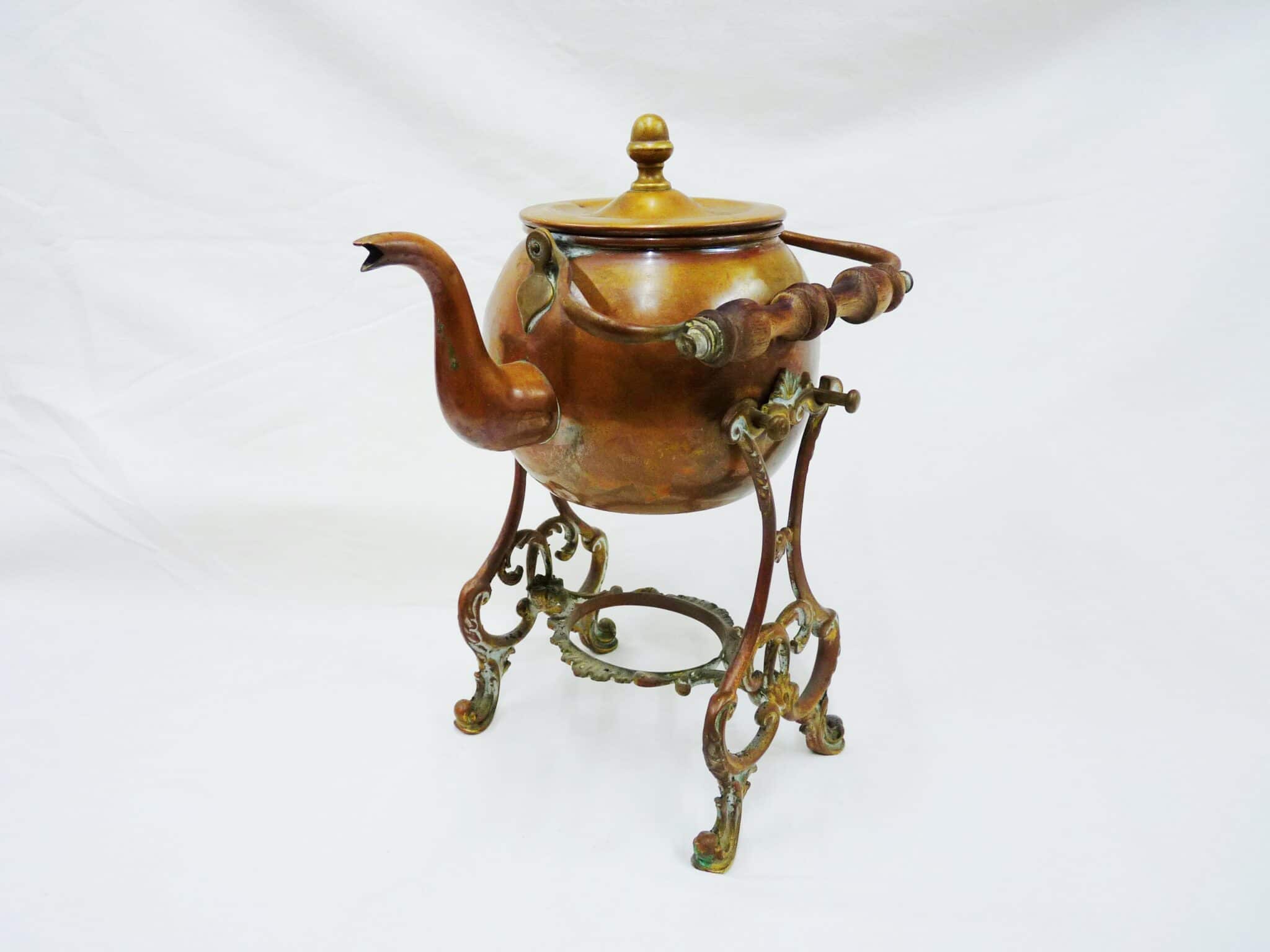
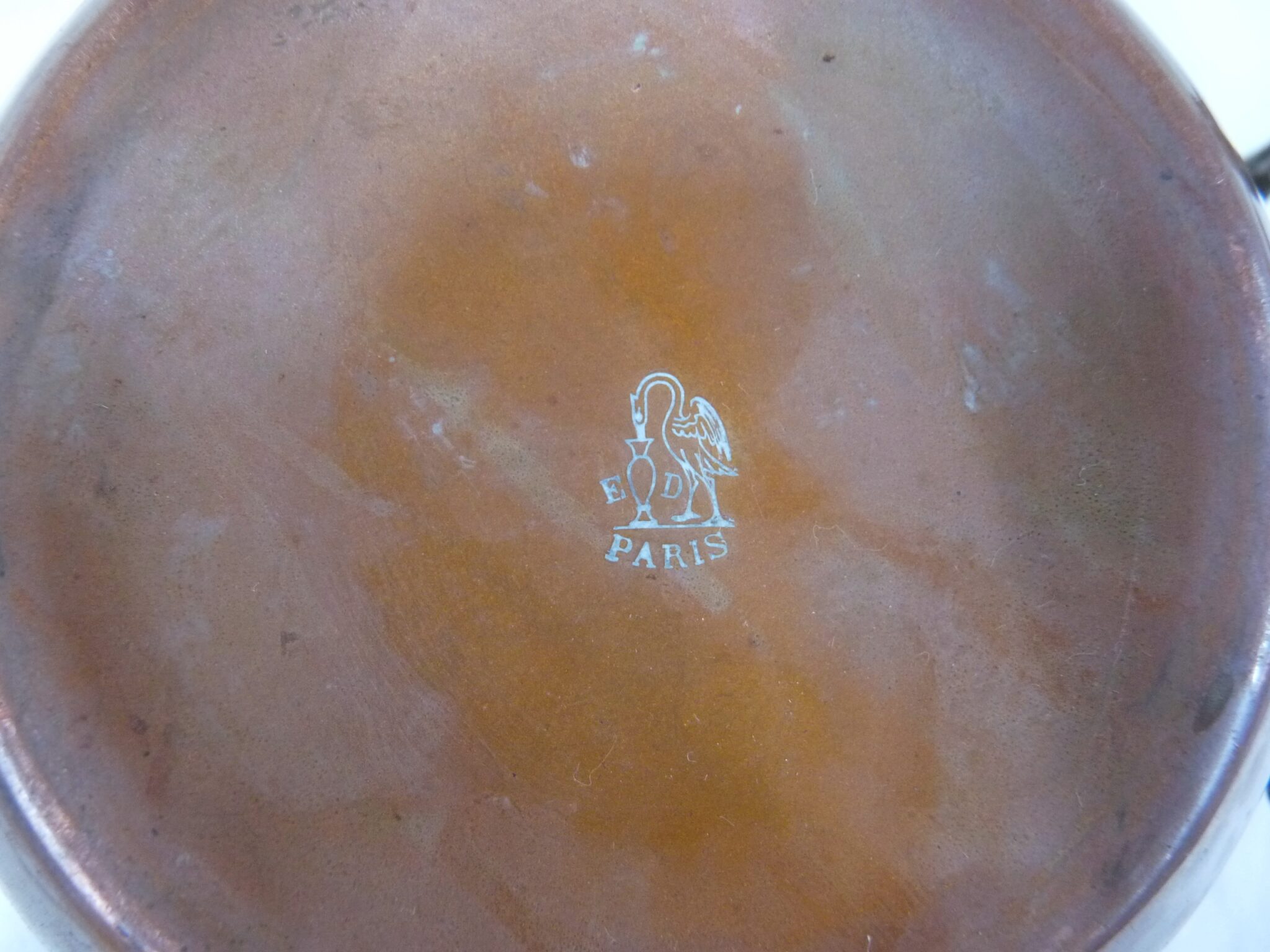
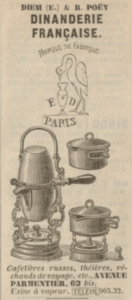 Dear V.,
Dear V.,
The “ED” in the logo stands for E. Diem and the stamp is for Dinanderie Française. The company specialized in cafetières russes, a style of coffeemaker with a central horizontal pivot, as well as théières like yours. The listing at right is from the 1900 edition of the business almanac and shows the company at 62 bis Avenue Parmentier in Paris.
According to its advertisements, the company was founded in 1886. By 1900, as shown at right, E. Diem had been joined in the venture by R. Poëy. I see the firm listed in 1928, but there is a break in the online records available to me, and the next industrial listings for 1935 have no listing for E. Diem. But there is “La Dinanderie Francaise” at 28-30 Rue du Borrégo — perhaps the next iteration of the firm?
In any event, primary sources establish that the company existed with that crane logo from 1886 to at least 1928.
I hope this helps put some context around this lovely piece! Enjoy it!
Dear VFC,
I have a dovetailed heavy copper bain marie base with rimmed perhaps beverage container (or soup?) with the mark of a crown, underneath P.F.D.N., then N. 4. I assume this was for a banquet type use, perhaps on a ship or luxury hotel? This is obviously a bain marie arrangement for maintaining a hot beverage or potage of sorts, and due to container size is probably for commercial purposes. When the beverage piece is inserted into the base pan, the total height is approximately 15½ inches [about 40cm].
I can find no information as to maker and would like help in identifying the heavy pot(s).
— K.C.
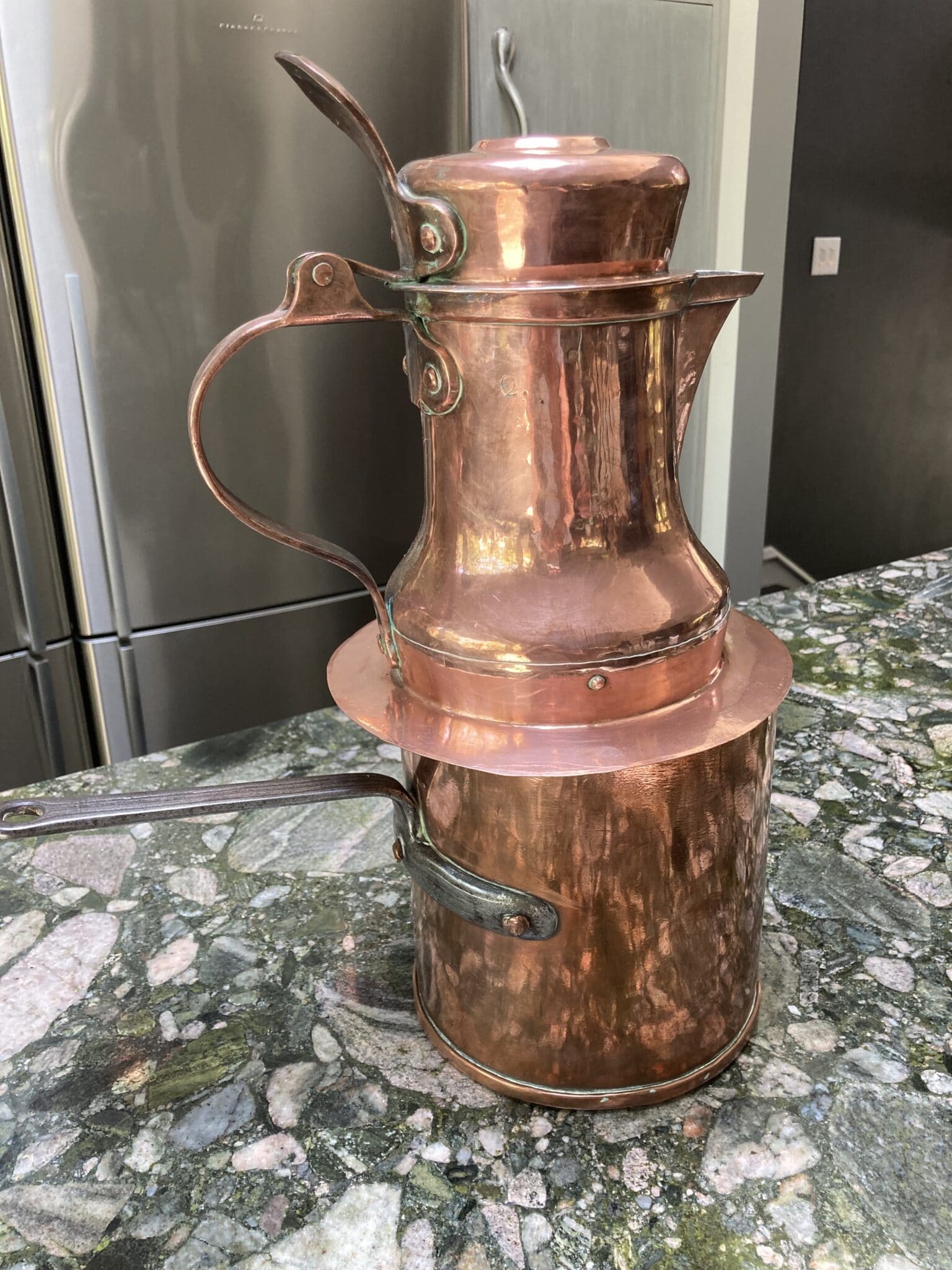
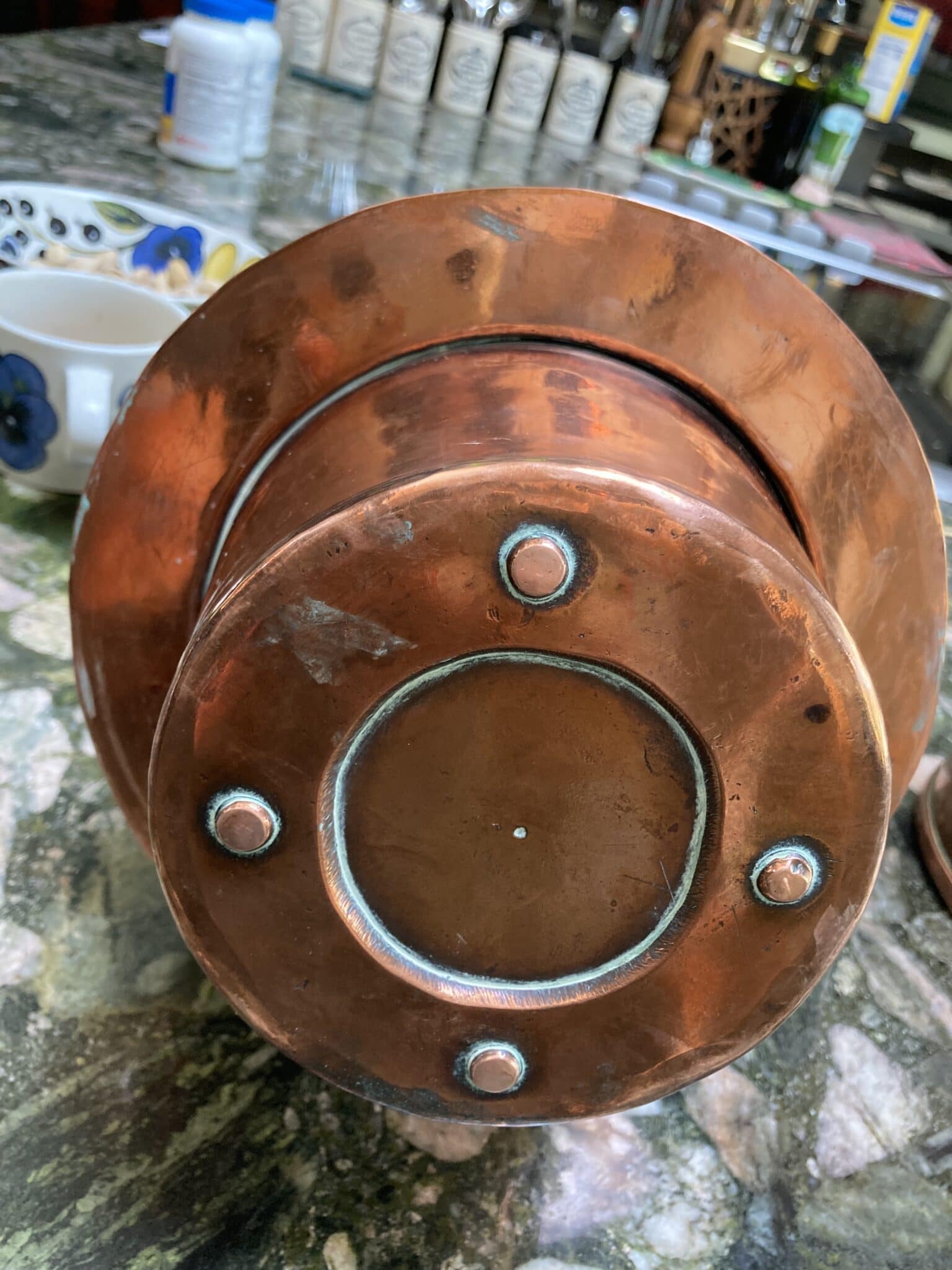

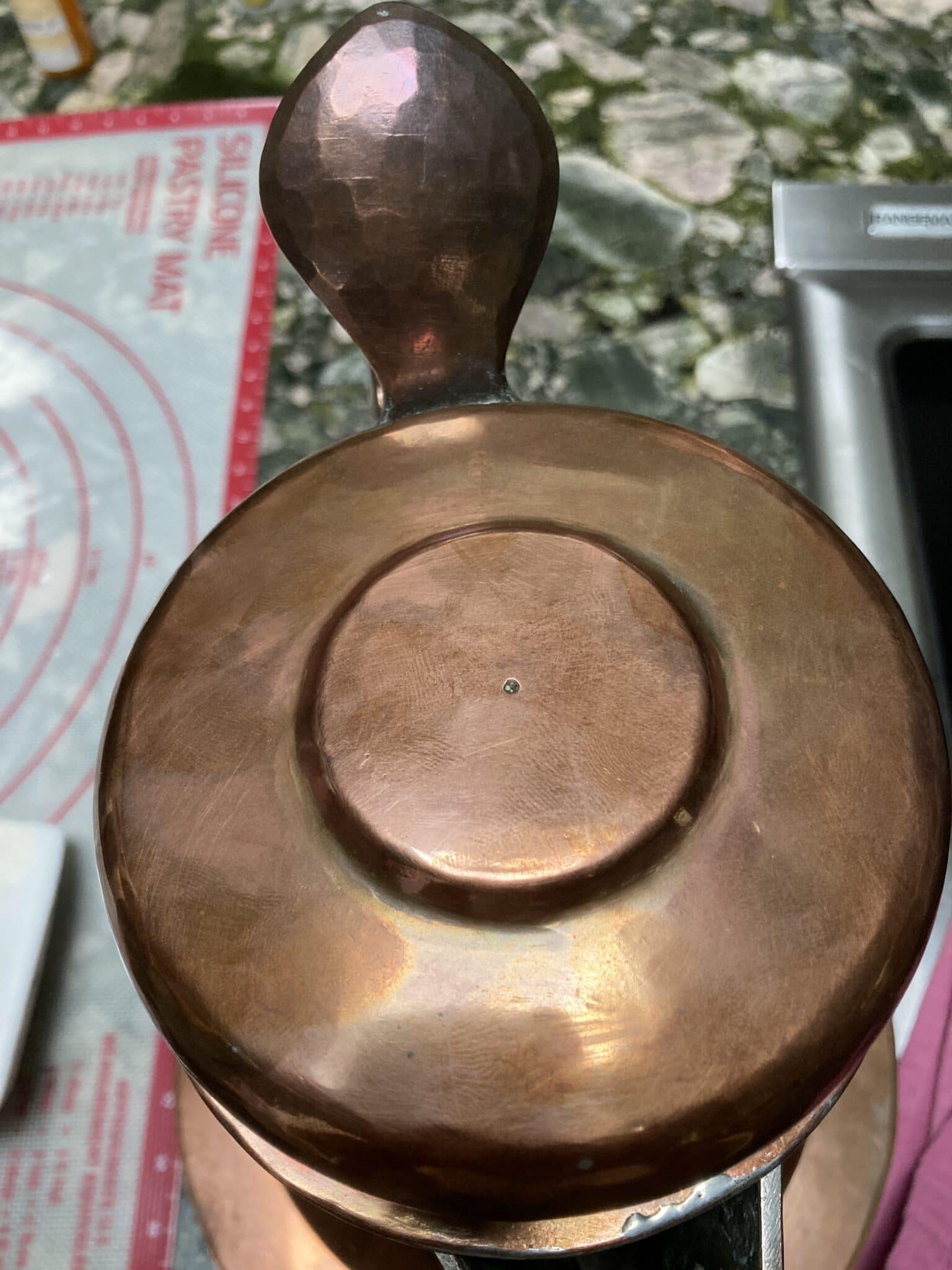
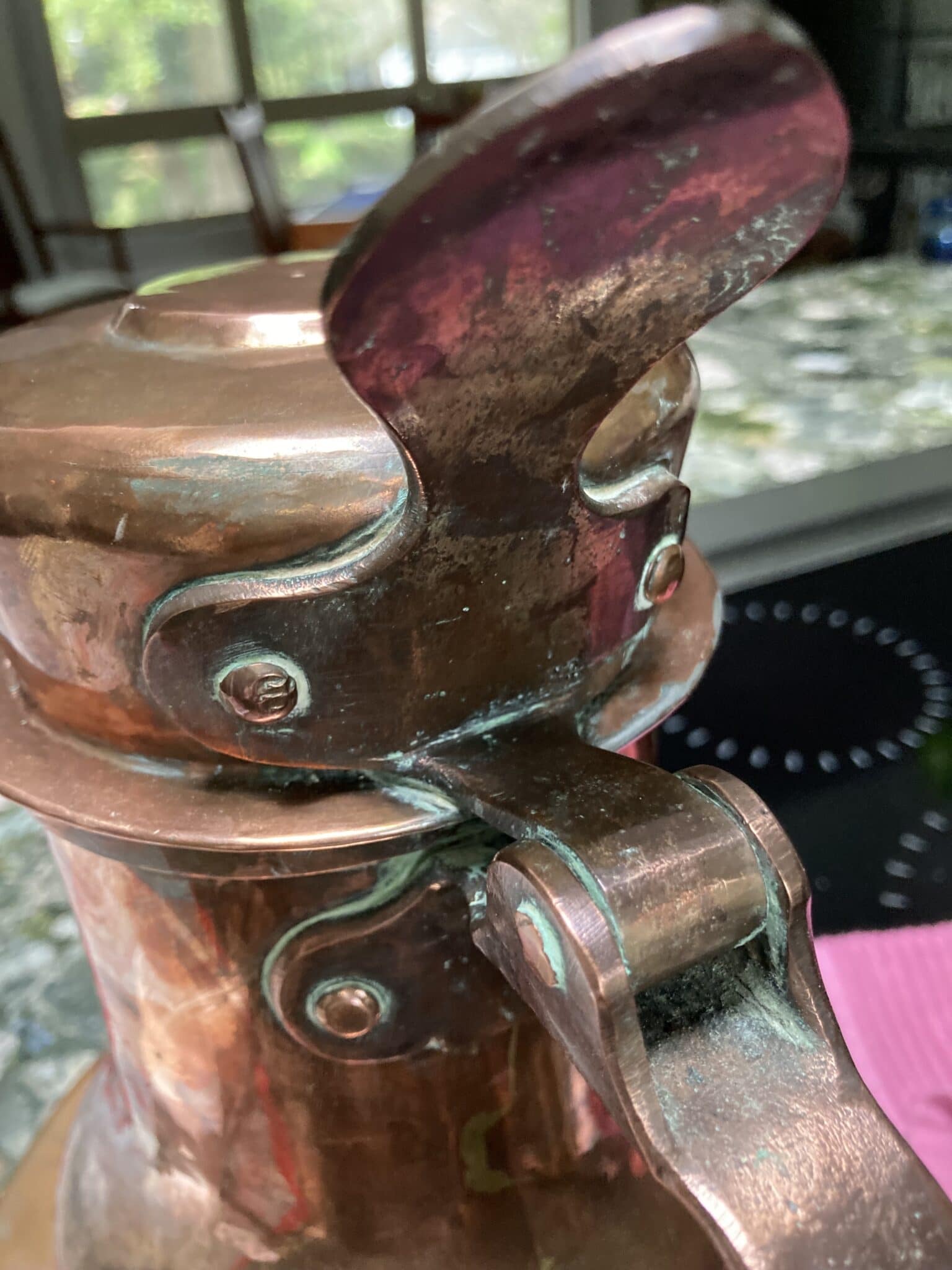
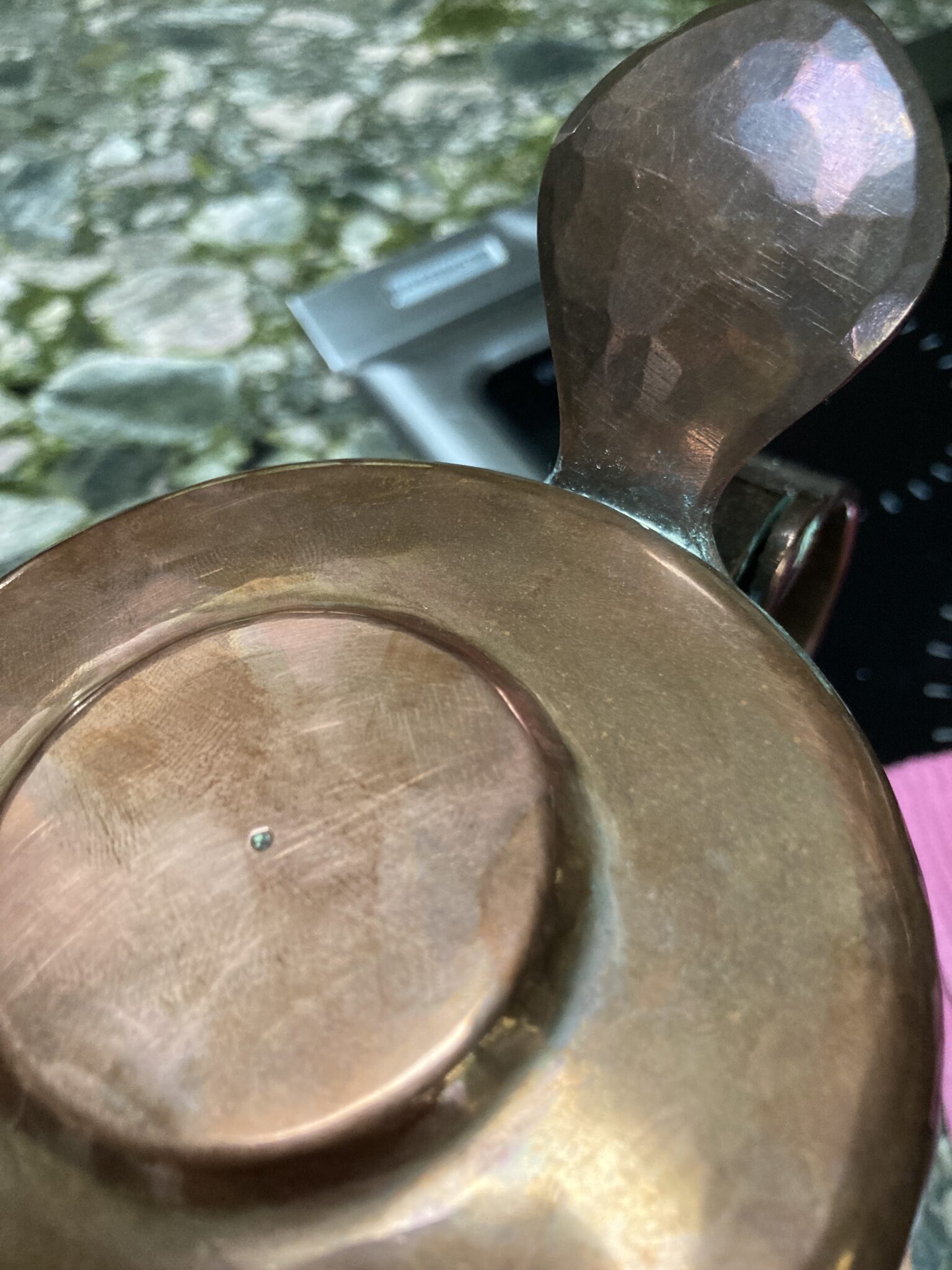
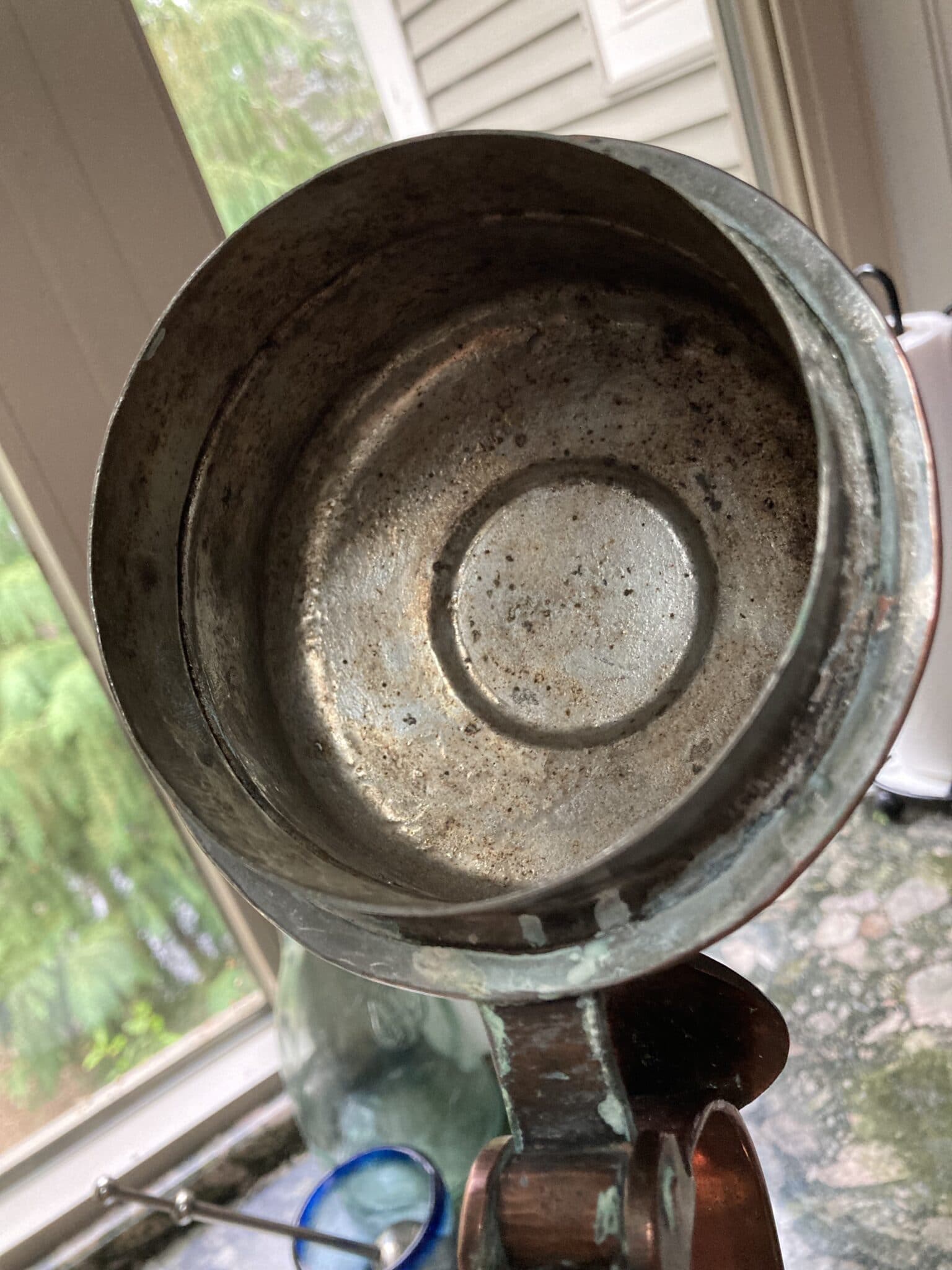
Dear K.C.,
First may I say, what marvelous pieces you have! All that elaborate hinge work around the lid is just gorgeous. John Fuller’s The Art of Coppersmithing has given me a deep appreciation for the amount of handwork it would have taken for a piece like this. And the care taken with the base — those four little button “feet” will keep it stable. It’s not only beautiful but also clever.
I agree with you that it was part of a bain marie setup. My theory is that it’s a chocolate pot for gently melting and mixing a chocolate drink. There would be no filter required for this, just a way to melt the chocolate without breaking or burning it. (It could also be for coffee or tea, of course, but those drinks don’t require the thermal protection of a bain marie.)
I’m not convinced the lower pot is an original part of the set, but it very well could be. The upper pot looks early 19th century to me, and the lower pot could also be of that era. That pot’s iron handle does not look French to me and very well could be English (or possibly Austrian?). I note that both the upper and lower pots have crimp seams which suggests they might be contemporaneous.
The coronet looks to be quite English and kingly to me — usually a coronet with an upper topknot is reserved for the king and royal blood — but I don’t know what PFDN could represent.
I haven’t seen other chocolate pots with this bain marie style construction — readers, what do you think of my theory? And do you have any thoughts about PFDN?
Dear VFC,
I have a pan I have been trying to identify. I am still trying to figure out the purpose and age of this pan. It is tinned copper measuring approximately 20cm by 8cm tall, with rounded sides. It has a dot on the bottom, a small tight rolled edge. The bail handle is attached by copper riveted tabs on the edge. What is confusing me is the small size of the pan vs the very large bail handle, approx. 8-9mm thick. It appears to be forged, and is very large, reaching over 20cm above the pan. Any idea of its use and approximate age would be greatly appreciated.
— M.
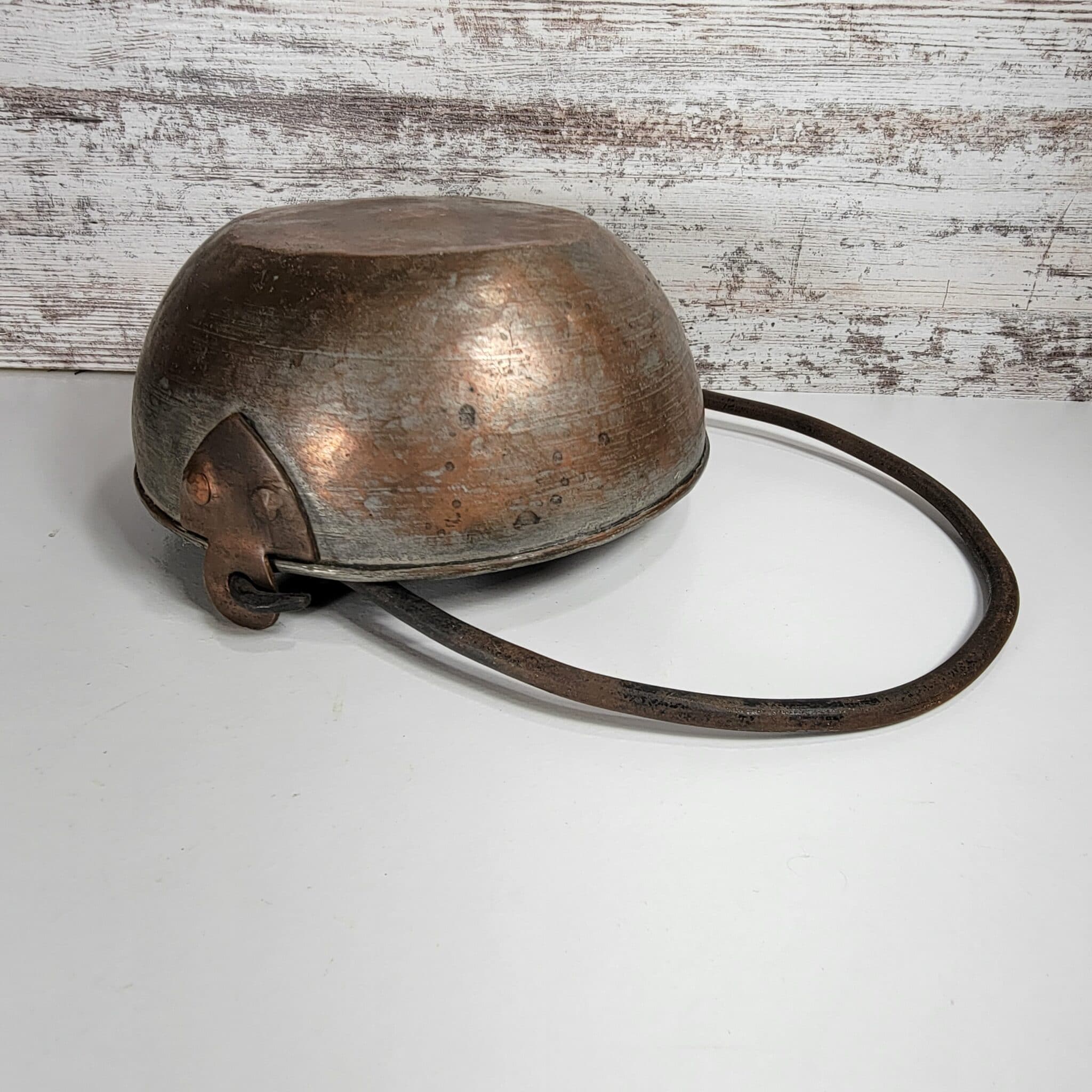
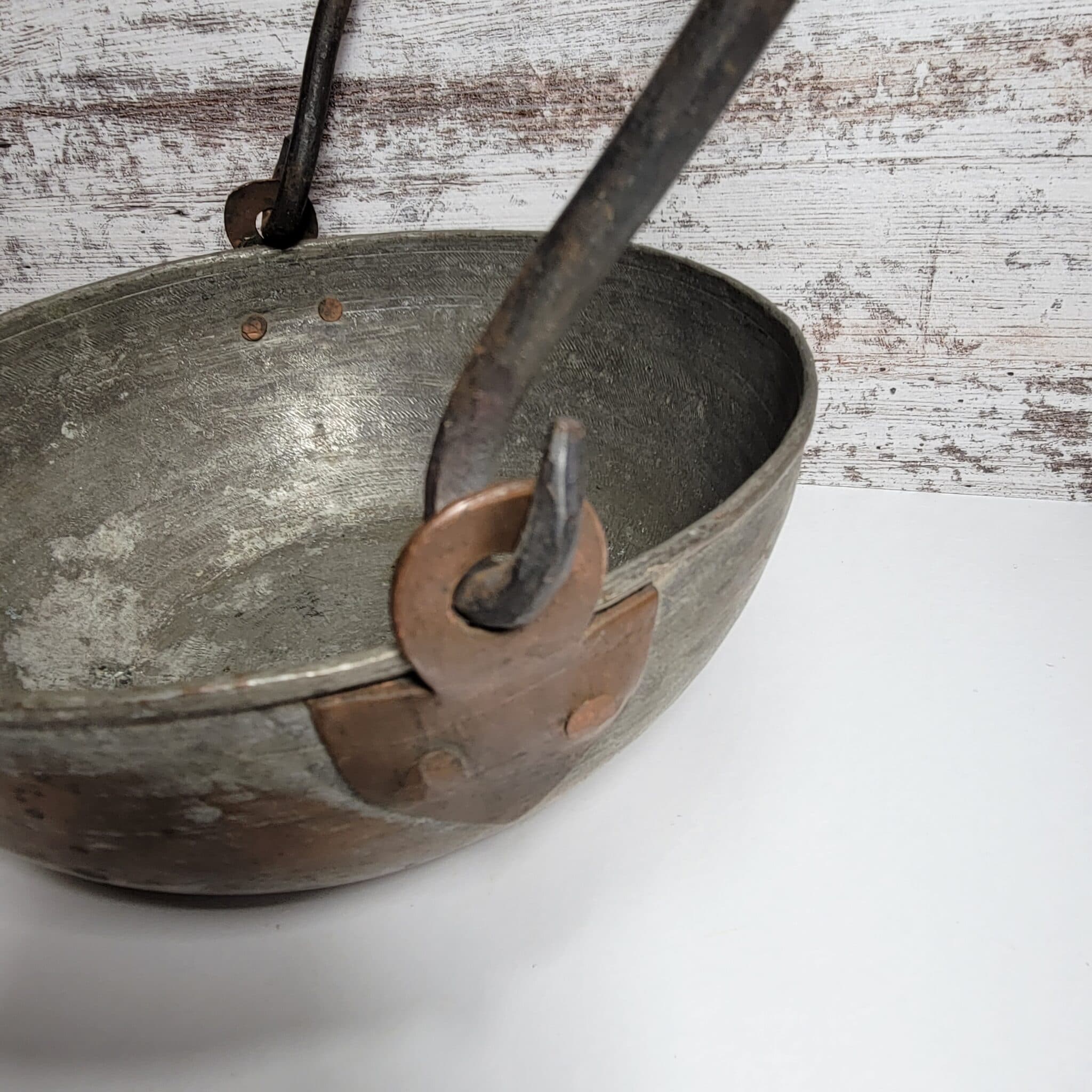
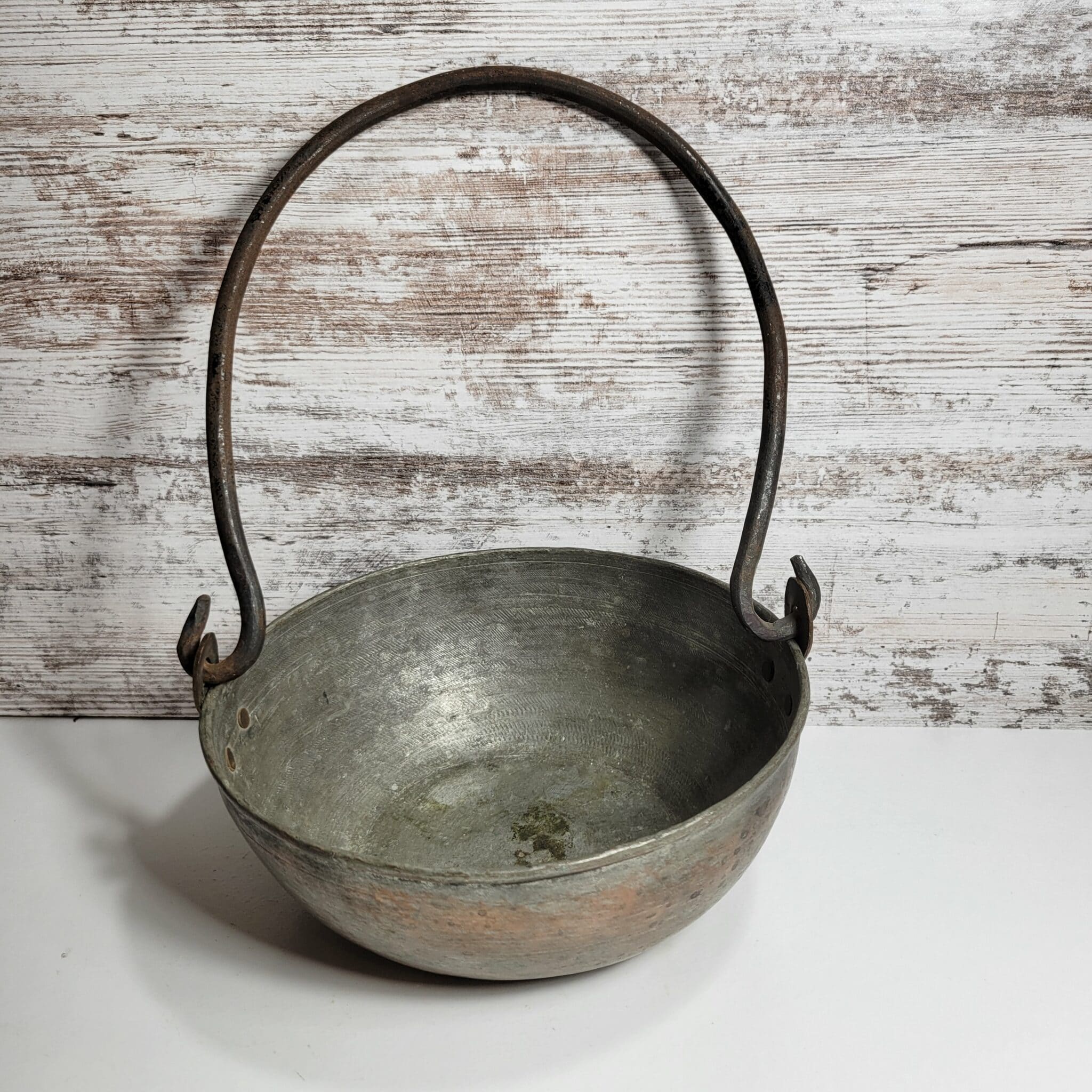

Dear M.,
It’s hard for me to assess this piece because I don’t think it’s French (or European), so a lot of the visual cues I look for aren’t there. My best guess at the moment is that it’s Turkish, but that is just a gut feel.
What I do see is that it was shaped on a spinning lathe. The exterior has very fine lines all around the circumference — I think those are remnants of the shaping tool. Spinning lathes are ancient technology and there are many 19th century pieces shaped this way — they are all usually thin copper, perhaps 1-2mm thick maximum, because of the amount of force required to turn the lathe and force the metal into shape. Metal spinning lathes in the 20th century were much more powerful and you will see a range of pieces shaped this way.
So at this moment in time I can’t say whether this is a 19th century piece, or a 20th century piece made to look like a 19th century piece. The high bail handle is intended for hearth cooking — there would be some kind of hook or arm that pivoted over the flame. But again, the techniques to make this piece have existed since the 1800s and are still practiced today. It looks suspiciously perfect to my eye, which inclines me to suspect it’s a more recent piece, but I am not really in a position to say for sure.
Readers, what do you think? Have you seen more pieces like this?
Letter writers have granted me permission to share their questions. Some emails may be lightly edited for clarity or to condense multiple messages into a single question. Names and identifying details have been obscured for privacy.
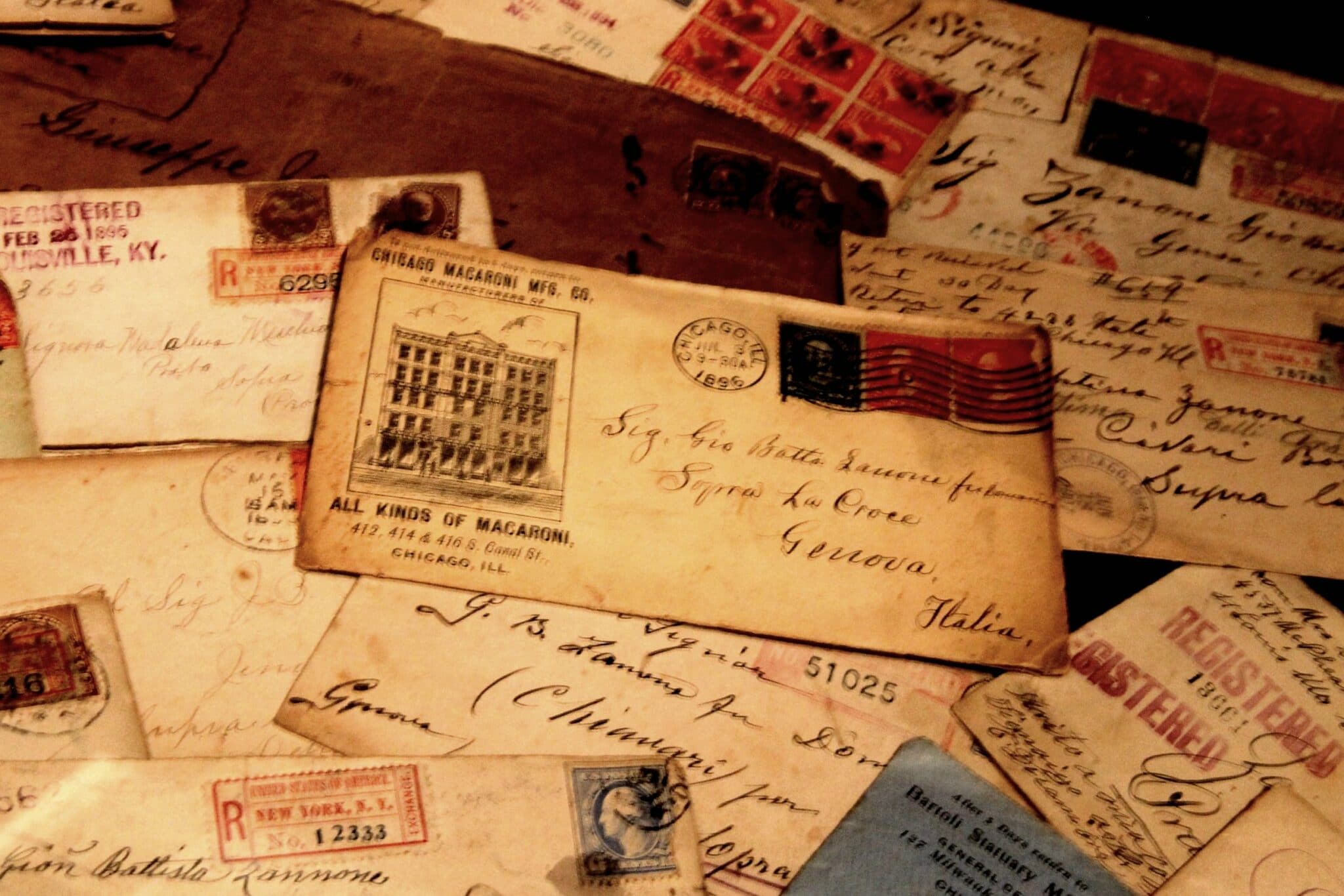
The chocolate pot if that is what it is has a wide flange to fit any pan of approximately the right size. The beautiful exaggerated hammering on the thumb piece screams “arts and crafts ” to me. The base looks to be a perfectly nice mid nineteen century saucepan, quality but utilitarian. My guess is that the jug is for gravy.
The last piece has clearly been modified, the handle has been closed inwards to fit a smaller diameter, it may have come off a bucket. The copper brackets and the rivets have not been tinned and are relatively bright so done fairly recently. The bowl has tin which is old enough to be oxidized, it may be for food use but the shape is just like the dipping bowls used for bailing hot water when doing laundry manually. Such a scoop would have a wooden handle on the side and I cannot see from the photos whether there is any sign of such an attachment.
As I study the jug more closely I am becoming suspicious of the flange which seems rather thin and not of the same quality as the rest of the piece. Without the flange it would be a hot water jug, the kind that servants carried to a gentleman’s room for shaving. So hard to be sure without handling it.
Roger, I also noticed the lovely hammering on the thumb piece of K.C.’s jug — it is beautiful work.
Your observations about M’s piece are intriguing. I hadn’t noticed that the bail handle appears to have been reshaped. And I think you are right that the brackets are a later addition. Any thoughts on the age of the bowl? Do you agree that the bowl was lathe-spun, or could the external texture have another cause?
So difficult to tell from a photo. It appears to be quite thin so raising by hand wouldn’t take a practiced hand very long. It has an Eastern European look about it.
The saucepan handle made me think of the A. Fauser & Sohn design. Is this an Austrian trait or could this be a Fauser pan that predates the ones we know about?
I first learned about Fauser & Son pans here on VFC. Later I saw some more products from this manufacturer on the Internet. The saucepans were all equipped with a handle that shows great similarity to the handle of the saucepan that serves as a bain marie under the coffee pot. Nearly horizontally angled handles seem to have been common for a time in parts of Europe (e.g. A, UK, D).
I still have photos of a very old saucepan from this Viennese manufacturer and k.u.k. Court supplier, which also has a precise royal stamp and monogram M.T. for Maria Theresa. Despite the poor legibility of the royal stamp on the coffee pot, I see a great match here.
But it is quite astonishing that a coffee pot with a royal stamp, of all things, has no complementary maker’s or store stamp. Unfortunately, also my extensive research on the PFDN stamp remained without result.
Roger, I had the same thought. The slender handle on the A. Fauser handles is very distinctive — I wonder if it’s an Austrian aesthetic?
What a wonderful new addition to your site, VFC! A “rapid fire” question and answer format is something I look forward to seeing more of! Cheers to an interesting opening episode!
I’m so glad you like it, Ian! I get great questions from readers — some I can answer, but many leave me stumped and I’m hoping that the wider readership of the site can help.
The Schwabenland catalog from 1922, which is over 330 pages long, contains a huge number of different devices for preparing coffee, tea or chocolate and a no smaller number of warming vessels. Here I found a “Sudkanne” or “Bouilloire à café, facon viennoise en cuivre martelé”, which looks confusingly similar in every detail to the K.C. pot. Austria, and Vienna in particular, has a long tradition of making coffee. Viennese coffee houses are famous for their special atmosphere and confectionery (for example, the “Sacher” with the famous Sacher cake). The pot in the catalog was offered without its own bain marie, but with the same ring-shaped support that adapts to different sizes of warming vessels is available. There is also a chocolate stove in the catalog, but it is of plain cylindrical shape and has a wooden handle. If I remember correctly, wooden handles are more common in chocolate stoves. The cylindrical shape makes it easier to stir the chocolate.
Regrettably, the stamp of the (presumably) royal crown is badly faded and also photographed out of focus. But a crown would fit well the origin of the coffee pot from the Austrian monarchy, which I suspect. Likewise, the handle of the bain marie, might support VFC’s thesis that the handle of this vessel indicates manufacture in Austria.
By the way, I found another coffee maker in the catalog with which the special Viennese coffee could be prepared. It reminded me of a “French press”, except that in the Austrian version the coffee grounds are not pressed down with a sieve, but the coffee powder is slowly pulled up out of the hot water with a sieve operated by a spindle.
Translated with http://www.DeepL.com/Translator (free version)
Unfortunately, from the photos it is not clear whether the coffee was prepared in the pot of K.C. or whether the pot was only intended for keeping warm and serving coffee. A filter insert or strainer is apparently missing. However, a strainer or filter is usually needed to prepare coffee.
Not so with Turkish coffee. In this simplest type of preparation, a somewhat coarse ground coffee in the cup or pot is poured over with hot water. Now you wait until the coffee powder has (largely) settled and flavored the water. Since there is always some of the coffee powder floating in the cup, this coffee tastes somewhat “rough”.
The special Viennese way of brewing, using a strainer to slowly pull the coffee powder out of the pot, is more convincing to me than the French Press, where the powder is held in place by the strainer at the bottom of the pot, but can still affect the taste of the coffee and make it bitter over time. But both types of preparation should give a very digestible coffee.
Since no one has mentioned the beautiful lead photo yet, I’d like to make up for it. I love handwritten letters or even postcards. A sensual blessing with all the digital media that flood us today. Unfortunately, the art of a beautiful handwriting is almost extinct.
Thank you! I plan to use this same graphic for future editions of Dear VFC so readers can recognize it. I find the handwriting beautiful as well.